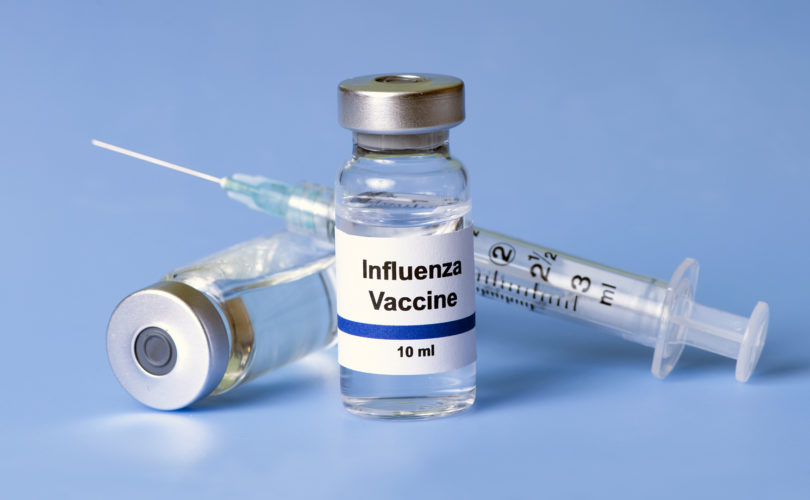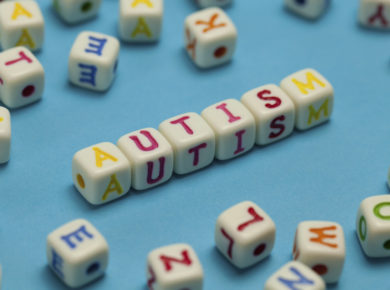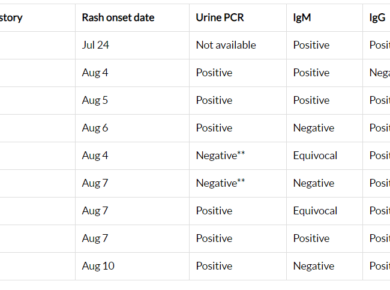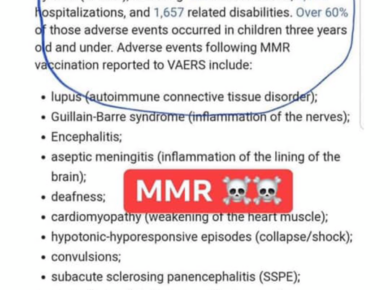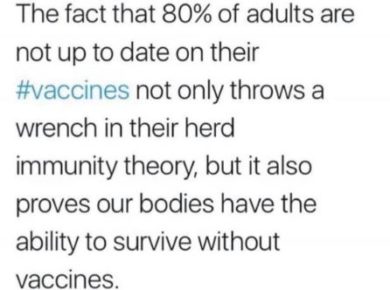We can agree that the flu vaccine is most likely the most useless vaccine ever. Year after year, the Cochrane Collaboration demonstrates this point that the flu shot does not help to prevent someone to get the flu.
On average, this vaccine is about 10-15% effective, which is ridiculous!
I recently covered this in a previous blog:
But several clinical observations seem to suggest that getting the flu vaccine increases your risk of having the flu, which is completely counterintuitive.
Is this possible?
Yes, it is!
First, you have the phenomenon of shedding.
According to the CDC:
“Shedding of the live attenuated vaccine virus is common after receipt of LAIV. In general, shedding is more common among younger recipients, among whom it may also be of longer duration. Among 345 LAIV3 recipients aged 5–49 years for whom shedding was assessed by viral culture of nasal swabs, 29% had detectable virus in nasal secretions. Prevalence of shedding was inversely related to age, and maximal shedding occurred within two days of vaccination. In a study of 200 children aged 6 through 59 months, shedding of at least one vaccine virus was detected in 79% of children overall, and was more common among younger children (89% of 6- through 23-month-olds as compared with 69% of 24- through 59-month-olds). Shedding had stopped in most cases by 11 days post-vaccination. Transmission of shed LAIV vaccine viruses from vaccine recipients to unvaccinated persons has been documented but has not been reported to be associated with serious illness. One study of 197 children aged 9–36 months (98 of whom received LAIV3 and 99 of whom received placebo) in a child care center assessed the potential for transmission of LAIV3 vaccine viruses. Among vaccine recipients, 80% shed one or more vaccine virus (mean duration: 7.6 days).”
https://www.cdc.gov/flu/professionals/acip/safety-vaccines.htm
It is funny to me that several pro-vaxxers are convinced that shedding is not a thing. I hear that all the time. They do not want to face reality, so they deny it. Denying it does not mean it is true 😊 They are just trying to convince themselves of their own lies.
The CDC thinks otherwise.
As a matter of fact, there are hundreds of cases of shedding that you can find in the medical literature. Yes, shedding is a thing.
But that is not the point of this blog.
Second, I want to go over how getting the flu vaccine “appears” to give you the flu.
You can get some insights by reading these two papers.
The first one is:
“Suppression by Thimerosal of Ex-Vivo CD4+ T Cell Response to Influenza Vaccine and Induction of Apoptosis in Primary Memory T Cells” published in PloS One in 2014
You can read it yourself:
https://www.ncbi.nlm.nih.gov/pmc/articles/PMC3972181/
The authors conclude:
“Overall, these results underline the proapoptotic effect of thimerosal on primary human lymphocytes at concentrations 100 times less to those contained in the multidose vaccine, and they reveal the inhibitory effect of this preservative on T-cell proliferation and functions at nanomolar concentrations.”
Yep, you read it right. Mercury at concentrations 100 times less to those found in the multidose vaccine is very toxic. Some scientists claim mercury is actually more dangerous than uranium. The point we need to remember is that mercury is very, very toxic to the human body.
They continue:
“We report that ex-vivo exposure of quiescent or TCR-activated primary human T cells to thimerosal induced a dose-dependent apoptotic cell death associated with depolarization of the mitochondrial membrane, generation of reactive oxygen species, cytochrome c release from the mitochondria and caspase-3 activation.”
“The toxic and immunomodulatory effects of thimerosal that we report herein have been detected at the final concentration of 30 ng/ml to 3 μg/ml, i.e., 3000 to 30 times less concentrated than in the vaccine.”
“These observations suggest that thimerosal may alter in vivo vaccine-induced immunity.”
“The dose-dependent toxic effect of thimerosal was detected after a short-term (16 h) exposure to the agent in both unstimulated and TCR-stimulated CD4 and CD8 T cells, but also in other blood mononuclear subsets such as NK cells, monocytes or B cells, indicating a broad effect of the agent on the effectors of the immune system.”
“IFN-γ contributes to macrophage activation by increasing phagocytosis and priming the production of proinflammatory cytokines and potent antimicrobials. It also controls the differentiation of naive CD4 T cells into Th1 effectors, which mediate cellular immunity against viral and intracellular pathogens. Inhibition of IFN-γ production following exposure to thimerosal may be detrimental for vaccine-specific immunity if this effect occurred in vivo, as suggested by the essential role of T cells producing this cytokine in protection against illness in influenza antibody naïve individuals.”
In other words, mercury, at concentrations much less than found in the vaccine, kills our immune system by causing the death of a variety of immune system cells, like lymphocytes, NK cells, monocytes, among others.
Therefore, when you get the flu vaccine, your immune system is destroyed, suppressed, inhibited, which makes you more prone to other pathogens.
That is why the flu vaccine “appears” to give you the flu.
The other paper we need to look at is:
“Annual Vaccination against Influenza Virus Hampers Development of Virus-Specific CD8+ T Cell Immunity in Children,” published in 2011 in the Journal of virology.
This is the link:
https://www.ncbi.nlm.nih.gov/pmc/articles/PMC3209321/
The authors declare:
“These findings are in concordance with our results in the mouse model, in which we demonstrated that vaccination against seasonal influenza A virus prevented the development of influenza A virus-specific CD8+ T cell immunity otherwise induced by infection.”
In this study, the researchers did not investigate why this is happening in vaccinated people.
But we just saw that mercury is most definitely an explanation of this observation.
Thus, getting the flu vaccine impairs the development of immunity against the same virus!
See, this is just insane!
Imagine the damage to the body if you get the flu vaccine every year…
The 2014-15 season was an exceptionally bad one for flu vaccine effectiveness (VE) in both Canada and the United States, with a nonsignificant VE of just 9% in Canada, notes the study.
In the United States, overall VE for the season was estimated at 23%.
The authors described the poor flu VE in 2014-15 as the result of a “perfect storm” of conditions that included antigenic drift in the circulating viruses and the use of the same flu strains in the vaccine two years in a row, along with the effects of repeated vaccination.
That does not sound too good!
Brendan Flannery, Ph.D., lead investigator with the US Centers for Disease Control and Prevention’s (CDC’s) Influenza Vaccine Effectiveness Network, said the CDC’s findings on flu VE in 2014-15 were similar to the Canadian results overall
The study was conducted by Canada’s Sentinel Practitioner Surveillance Network (SPSN), consisting of a number of outpatient clinics in British Columbia, Alberta, Ontario, and Quebec.
In this approach, patients who seek care for influenza-like illness (ILI) are tested for flu, and their vaccination status is determined. Flu VE is calculated by comparing the numbers of vaccinated and unvaccinated patients who test positive.
The researchers included 1,939 patients who sought care between Nov 1, 2014, and Apr 30, 2015, about 63% of whom were non-elderly adults.
Overall, 36% of them had received a flu shot, and this proportion did not differ significantly between those who tested positive for the virus (34%) and those who did not (36%), the report says.
Among patients who received the 2014-15 flu vaccine and were old enough to have been vaccinated in previous seasons, 87% (567 of 655) had also been vaccinated in 2013-14, and 82% (507 of 618) had received the flu shot each season since 2012-13.
Of 1,939 patients, 814 (42%) tested positive for flu, with 590 (72%) having influenza A and 225 (28%) influenza B. Almost all (99%) of the type A viruses were H3N2 isolates.
The overall effectiveness of the 2014-15 vaccine against medically attended flu was found to be 9%.
The adjusted VE against all H3N2 viruses was 16%.
In looking for prior-vaccination effects, the team found that the VE against H3N2 for those vaccinated in 2014-15 but not the year before was 53%.
For those vaccinated in all three seasons ending in 2014-15, VE against H3N2 was estimated at 54%, suggesting a significant increase in the risk of flu because the entire confidence interval was less than zero.
VE in those vaccinated in 2014-15 but not in 2013-14 was 61%, while VE for those vaccinated in both seasons was 33%.
For participants vaccinated three years in a row, VE was just slightly lower, at 28%.
In their virologic analyses, the team found that the H3N2 viruses had 10 to 12 antigenic amino-acid changes relative to the 2014-15 vaccine virus.
Skowronski said it has been recognized for decades that prior vaccination can affect flu VE.
Some recent studies suggesting that consecutive-year vaccination can lower VE have come from the University of Michigan and the European Union’s flu surveillance network.
The Michigan group found the effect in studies of households in the 2010-11 and 2012-13 flu seasons, while the European network observed the effect in the 2014-15 season.
In a Feb 18 report in Eurosurveillance, the European authors wrote that the finding was “congruent with the hypothesis that prior immunization may decrease the effectiveness of the vaccine and that this negative interference is more important when the antigenic distance is small between successive vaccine components but large between the vaccine and circulating strain.”
Skowronski said her group’s new findings represent only the second time the Canadian SPSN has found evidence that prior-year vaccination can go beyond “blunting” and actually increase the risk of flu, the first time having been in the 2009 pandemic.
In that case, the pandemic H1N1 virus was “drastically mismatched” with the H1N1 strain in the prior year’s seasonal flu vaccine, she noted.
The new study marks the first suggestion that vaccination more than two years in a row can increase the risk of infection with a drifted seasonal flu strain.
“It’s the lowest VE in a decade,” she added. “We can’t just report that and move merrily along and hope it won’t happen again.”
The Canadian study won praise from another researcher who studies flu VE, Lisa Jackson, MD, MPH, a senior investigator with the Group Health Research Institute in Seattle.
“I think this is a really good paper,” she commented via e-mail. “Their results are consistent with results that will be reported from the US Flu VE network, but our VE estimates were higher. The evidence for a detrimental effect of prior vaccination needs to be interpreted cautiously, as indicated, but has been reported in multiple prior publications and is consistent with lower HI [antibody] titers post-vaccination in persons previously vaccinated.”
Every year, those who swear by the influenza vaccine eagerly get jabbed. Others vehemently maintain that flu shots are either useless or do more harm than good. The latter camp, however, may now have some additional ammunition.
In conclusion, these studies and others are raising the specter that the more influenza vaccinations you receive in your lifetime, the less protection you have from the virus in subsequent seasons. In addition, they suggest that getting the flu vaccination would make you sick!
God bless y’all 😊
Dr. Serge

